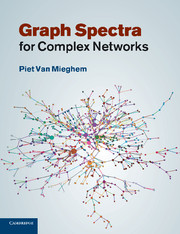Book contents
- Frontmatter
- Contents
- Preface
- Acknowledgements
- Symbols
- 1 Introduction
- Part I Spectra of graphs
- 2 Algebraic graph theory
- 3 Eigenvalues of the adjacency matrix
- 4 Eigenvalues of the Laplacian Q
- 5 Spectra of special types of graphs
- 6 Density function of the eigenvalues
- 7 Spectra of complex networks
- Part II Eigensystem and polynomials
- References
- Index
7 - Spectra of complex networks
Published online by Cambridge University Press: 01 March 2011
- Frontmatter
- Contents
- Preface
- Acknowledgements
- Symbols
- 1 Introduction
- Part I Spectra of graphs
- 2 Algebraic graph theory
- 3 Eigenvalues of the adjacency matrix
- 4 Eigenvalues of the Laplacian Q
- 5 Spectra of special types of graphs
- 6 Density function of the eigenvalues
- 7 Spectra of complex networks
- Part II Eigensystem and polynomials
- References
- Index
Summary
This chapter presents some examples of the spectra of complex networks, which we have tried to interpret or to understand using the theory of previous chapters. In contrast to the mathematical rigor of the other chapters, this chapter is more intuitively oriented and it touches topics that are not yet understood or that lack maturity. Nevertheless, the examples may give a flavor of how real-world complex networks are analyzed as a sequence of small and partial steps towards (hopefully) complete understanding.
Simple observations
When we visualize the density function fλ(x) of the eigenvalues of the adjacency matrix of a graph, defined in art. 121, peaks at x = 0, x = −1 and x = −2 are often observed. The occurrence of adjacency eigenvalue at those integer values has a physical explanation.
A graph with eigenvalue λ (A) = 0
A matrix has a zero eigenvalue if its determinant is zero (art. 138). A determinant is zero if two rows are identical or if some of the rows are linearly dependent. For example, two rows are identical resulting in λ (A) = 0, if two not mutually interconnected nodes are connected to a same set of nodes. Since the elements aij of an adjacency matrix A are only 0 or 1, linear dependence of rows occurs every time the sum of a set of rows equals another row in the adjacency matrix.
Information
- Type
- Chapter
- Information
- Graph Spectra for Complex Networks , pp. 179 - 208Publisher: Cambridge University PressPrint publication year: 2010
Accessibility standard: Unknown
Why this information is here
This section outlines the accessibility features of this content - including support for screen readers, full keyboard navigation and high-contrast display options. This may not be relevant for you.Accessibility Information
- 5
- Cited by
